battery SKODA FABIA 2004 1.G / 6Y Owner's Guide
[x] Cancel search | Manufacturer: SKODA, Model Year: 2004, Model line: FABIA, Model: SKODA FABIA 2004 1.G / 6YPages: 247
Page 103 of 247
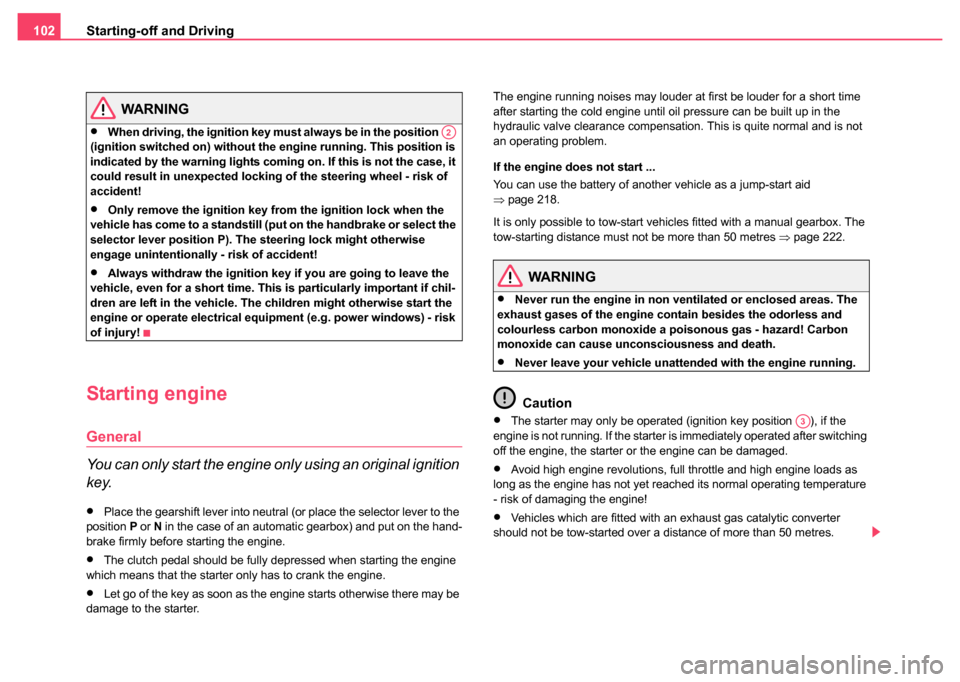
Starting-off and Driving
102
WARNING
•When driving, the ignition key must always be in the position
(ignition switched on) without the engine running. This position is
indicated by the warning lights coming on. If this is not the case, it
could result in unexpected locking of the steering wheel - risk of
accident!
•Only remove the ignition key fr om the ignition lock when the
vehicle has come to a standstill (put on the handbrake or select the
selector lever position P). The steering lock might otherwise
engage unintentionally - risk of accident!
•Always withdraw the ignition key if you are going to leave the
vehicle, even for a short time. This is particularly important if chil-
dren are left in the vehicle. The children might otherwise start the
engine or operate electrical equi pment (e.g. power windows) - risk
of injury!
Starting engine
General
You can only start the engine only using an original ignition
key.
•Place the gearshift lever into neutral (or place the selector lever to the
position P or N in the case of an automatic gearbox) and put on the hand-
brake firmly before starting the engine.
•The clutch pedal should be fully depressed when starting the engine
which means that the starter only has to crank the engine.
•Let go of the key as soon as the engine starts otherwise there may be
damage to the starter. The engine running noises may louder at first be louder for a short time
after starting the cold engine until oil pressure can be built up in the
hydraulic valve clearance compensation. This is quite normal and is not
an operating problem.
If the engine does not start ...
You can use the battery of another vehicle as a jump-start aid
⇒
page 218.
It is only possible to tow-start vehicles fitted with a manual gearbox. The
tow-starting distance must not be more than 50 metres ⇒page 222.
WARNING
•Never run the engine in non ventilated or enclosed areas. The
exhaust gases of the engine contain besides the odorless and
colourless carbon monoxide a poisonous gas - hazard! Carbon
monoxide can cause unconsciousness and death.
•Never leave your vehicle unattended with the engine running.
Caution
•The starter may only be operated (ignition key position ), if the
engine is not running. If the starter is immediately operated after switching
off the engine, the starter or the engine can be damaged.
•Avoid high engine revolutions, full throttle and high engine loads as
long as the engine has not yet reached its normal operating temperature
- risk of damaging the engine!
•Vehicles which are fitted with an exhaust gas catalytic converter
should not be tow-started over a distance of more than 50 metres.
A2
A3
Page 104 of 247
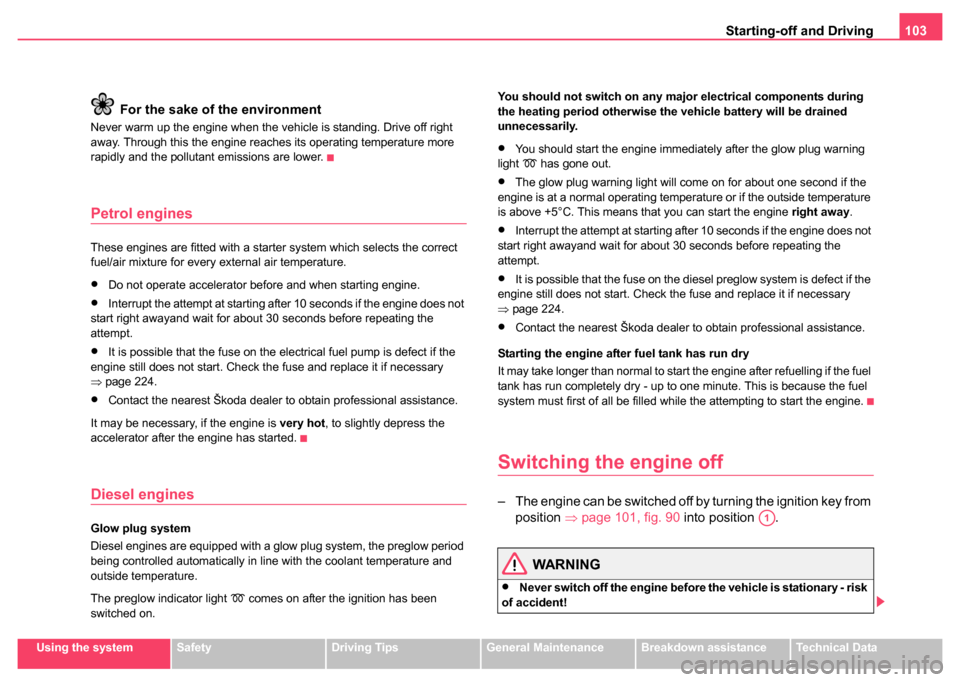
Starting-off and Driving103
Using the systemSafetyDriving TipsGeneral MaintenanceBreakdown assistanceTechnical Data
For the sake of the environment
Never warm up the engine when the vehicle is standing. Drive off right
away. Through this the engine reaches its operating temperature more
rapidly and the pollutant emissions are lower.
Petrol engines
These engines are fitted with a starter system which selects the correct
fuel/air mixture for every external air temperature.
•Do not operate accelerator before and when starting engine.
•Interrupt the attempt at starting after 10 seconds if the engine does not
start right awayand wait for about 30 seconds before repeating the
attempt.
•It is possible that the fuse on the electrical fuel pump is defect if the
engine still does not start. Check the fuse and replace it if necessary
⇒ page 224.
•Contact the nearest Škoda dealer to obtain professional assistance.
It may be necessary, if the engine is very hot, to slightly depress the
accelerator after the engine has started.
Diesel engines
Glow plug system
Diesel engines are equipped with a glow plug system, the preglow period
being controlled automatically in line with the coolant temperature and
outside temperature.
The preglow indicator light
comes on after the ignition has been
switched on. You should not switch on any major electrical components during
the heating period otherwise the vehicle battery will be drained
unnecessarily.
•You should start the engine immediately after the glow plug warning
light has gone out.
•The glow plug warning light will come on for about one second if the
engine is at a normal operating temperature or if the outside temperature
is above +5°C. This means that you can start the engine right away.
•Interrupt the attempt at starting after 10 seconds if the engine does not
start right awayand wait for about 30 seconds before repeating the
attempt.
•It is possible that the fuse on the diesel preglow system is defect if the
engine still does not start. Check the fuse and replace it if necessary
⇒ page 224.
•Contact the nearest Škoda dealer to obtain professional assistance.
Starting the engine after fuel tank has run dry
It may take longer than normal to start the engine after refuelling if the fuel
tank has run completely dry - up to one minute. This is because the fuel
system must first of all be filled while the attempting to start the engine.
Switching the engine off
– The engine can be switched off by turning the ignition key from position ⇒page 101, fig. 90 into position .
WARNING
•Never switch off the engine before the vehicle is stationary - risk
of accident!
A1
Page 115 of 247
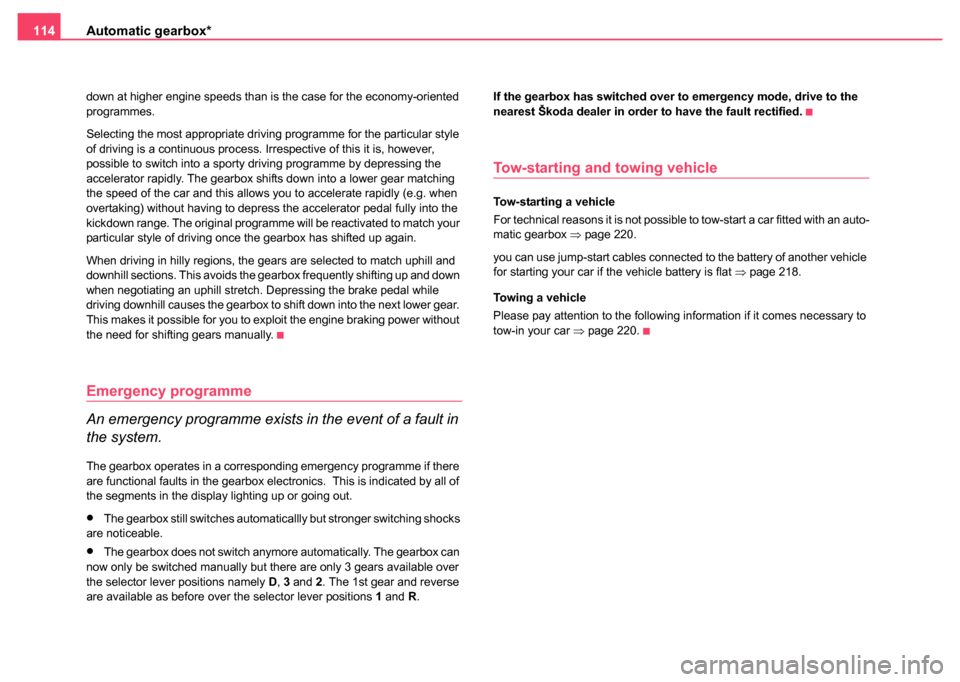
Automatic gearbox*
114
down at higher engine speeds than is the case for the economy-oriented
programmes.
Selecting the most appropriate driving programme for the particular style
of driving is a continuous process. Irrespective of this it is, however,
possible to switch into a sporty driving programme by depressing the
accelerator rapidly. The gearbox shifts down into a lower gear matching
the speed of the car and this allows you to accelerate rapidly (e.g. when
overtaking) without having to depress the accelerator pedal fully into the
kickdown range. The original programme will be reactivated to match your
particular style of driving once the gearbox has shifted up again.
When driving in hilly regions, the gears are selected to match uphill and
downhill sections. This avoids the gearbox frequently shifting up and down
when negotiating an uphill stretch. Depressing the brake pedal while
driving downhill causes the gearbox to shift down into the next lower gear.
This makes it possible for you to exploit the engine braking power without
the need for shifting gears manually.
Emergency programme
An emergency programme exists in the event of a fault in
the system.
The gearbox operates in a corresponding emergency programme if there
are functional faults in the gearbox electronics. This is indicated by all of
the segments in the display lighting up or going out.
•The gearbox still switches automaticallly but stronger switching shocks
are noticeable.
•The gearbox does not switch anymore automatically. The gearbox can
now only be switched manually but there are only 3 gears available over
the selector lever positions namely D, 3 and 2. The 1st gear and reverse
are available as before over the selector lever positions 1 and R. If the gearbox has switched over to emergency mode, drive to the
nearest Škoda dealer in order to have the fault rectified.
Tow-starting and towing vehicle
Tow-starting a vehicle
For technical reasons it is not possible to tow-start a car fitted with an auto-
matic gearbox
⇒page 220.
you can use jump-start cables connected to the battery of another vehicle
for starting your car if the vehicle battery is flat ⇒page 218.
Towing a vehicle
Please pay attention to the following information if it comes necessary to
tow-in your car ⇒page 220.
Page 116 of 247

Communication115
Using the systemSafetyDriving TipsGeneral MaintenanceBreakdown assistanceTechnical Data
Communication
Universal telephone connection*
A telephone mount is factory-fitted. The mount is attached to the
centre console. Adapter “Cullmann” and mobile phone are not
factory-fitted by Škoda Auto.
Initialisation
– Withdraw the ignition key.
– First insert the adapter without the mobile phone into the
mount in the direction of arrow ⇒fig. 97 until the
adapter is touching the stop. Press the adapter slightly in the
direction of arrow until it locks into position. – Plug the adapter cable into the mobile phone socket. The
power socket is located under the front passenger storage
compartment.
– Switch on the ignition.
– Wait for approximately 15 seconds, switch off ignition.
– Insert the mobile phone into the adapter (as specified in manufacturer's instructions) and switch on the ignition.
Removing the mobile phone and adapter
– Press the button and remove the mobile telephone.
An initialisation must be carried out:
•after the first connection of the adapter
•after reconnecting the battery
•after pulling out the adapter cable from the power socket for the mobile
phone
This enables you to make full use of the advantages of a normal carphone
(“handsfree system” using a microphone integrated in the vehicle, optimal
transmission of signals using an external aerial etc.). The battery of the
mobile phone is also constantly charged.
Please contact your Škoda dealer If there are any points which are not
clear.
Please also refer to the additional instructions ⇒page 116, “Mobile
phones and two-way radio systems”.
Fig. 97 Universal tele-
phone connection
ABA1
A2
AA
AC
Page 157 of 247
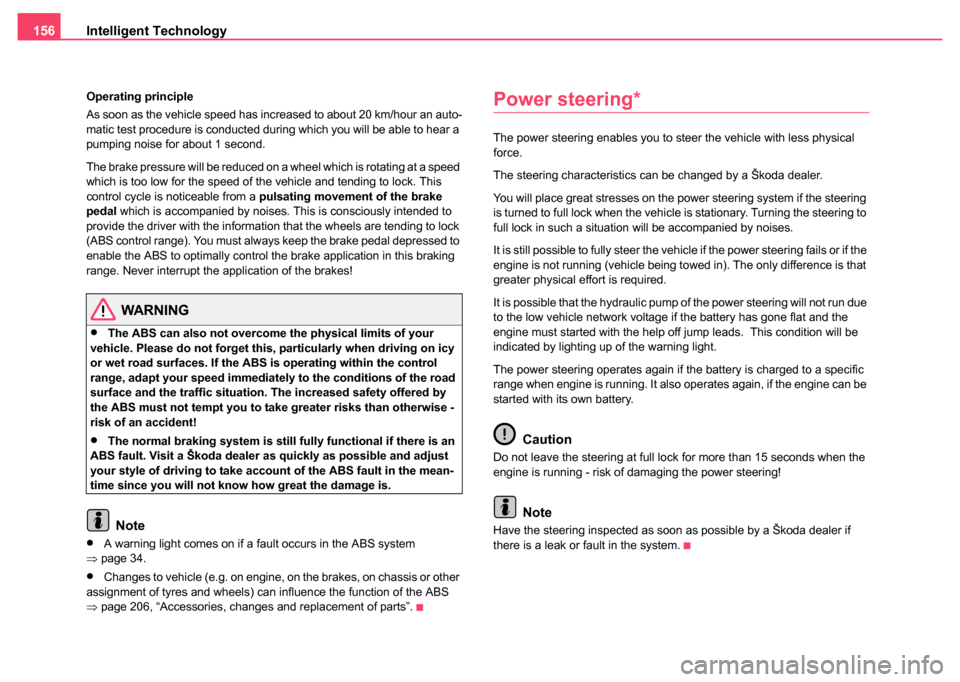
Intelligent Technology
156
Operating principle
As soon as the vehicle speed has increased to about 20 km/hour an auto-
matic test procedure is conducted during which you will be able to hear a
pumping noise for about 1 second.
The brake pressure will be reduced on a wheel which is rotating at a speed
which is too low for the speed of the vehicle and tending to lock. This
control cycle is noticeable from a pulsating movement of the brake
pedal which is accompanied by noises. This is consciously intended to
provide the driver with the information that the wheels are tending to lock
(ABS control range). You must always keep the brake pedal depressed to
enable the ABS to optimally control the brake application in this braking
range. Never interrupt the application of the brakes!
WARNING
•The ABS can also not overcome the physical limits of your
vehicle. Please do not forget this, particularly when driving on icy
or wet road surfaces. If the ABS is operating within the control
range, adapt your speed immediately to the conditions of the road
surface and the traffic situation. The increased safety offered by
the ABS must not tempt you to take greater risks than otherwise -
risk of an accident!
•The normal braking system is still fully functional if there is an
ABS fault. Visit a Škoda dealer as quickly as possible and adjust
your style of driving to take account of the ABS fault in the mean-
time since you will not know how great the damage is.
Note
•A warning light comes on if a fault occurs in the ABS system
⇒ page 34.
•Changes to vehicle (e.g. on engine, on the brakes, on chassis or other
assignment of tyres and wheels) can influence the function of the ABS
⇒ page 206, “Accessories, changes and replacement of parts”.
Power steering*
The power steering enables you to steer the vehicle with less physical
force.
The steering characteristics can be changed by a Škoda dealer.
You will place great stresses on the power steering system if the steering
is turned to full lock when the vehicle is stationary. Turning the steering to
full lock in such a situation will be accompanied by noises.
It is still possible to fully steer the vehicle if the power steering fails or if the
engine is not running (vehicle being towed in). The only difference is that
greater physical effort is required.
It is possible that the hydraulic pump of the power steering will not run due
to the low vehicle network voltage if the battery has gone flat and the
engine must started with the help off jump leads. This condition will be
indicated by lighting up of the warning light.
The power steering operates again if the battery is charged to a specific
range when engine is running. It also operates again, if the engine can be
started with its own battery.
Caution
Do not leave the steering at full lock for more than 15 seconds when the
engine is running - risk of damaging the power steering!
Note
Have the steering inspected as soon as possible by a Škoda dealer if
there is a leak or fault in the system.
Page 185 of 247
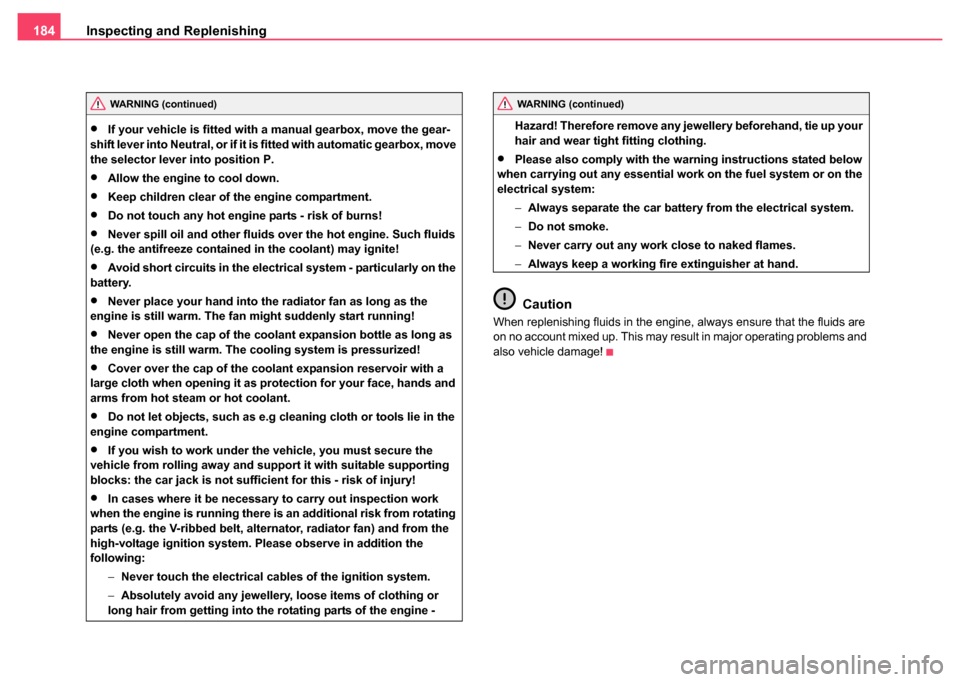
Inspecting and Replenishing
184
•If your vehicle is fitted with a manual gearbox, move the gear-
shift lever into Neutral, or if it is fitted with automatic gearbox, move
the selector leve r into position P.
•Allow the engine to cool down.
•Keep children clear of the engine compartment.
•Do not touch any hot engine parts - risk of burns!
•Never spill oil and other fluids over the hot engine. Such fluids
(e.g. the antifreeze contained in the coolant) may ignite!
•Avoid short circuits in the electrical system - particularly on the
battery.
•Never place your hand into the radiator fan as long as the
engine is still warm. The fan might suddenly start running!
•Never open the cap of the coolant expansion bottle as long as
the engine is still warm. The cooling system is pressurized!
•Cover over the cap of the coolant expansion reservoir with a
large cloth when opening it as protection for your face, hands and
arms from hot steam or hot coolant.
•Do not let objects, such as e.g cleaning cloth or tools lie in the
engine compartment.
•If you wish to work under the vehicle, you must secure the
vehicle from rolling away and support it with suitable supporting
blocks: the car jack is not sufficient for this - risk of injury!
•In cases where it be necessary to carry out inspection work
when the engine is running there is an additional risk from rotating
parts (e.g. the V-ribbed belt, alternator, radiator fan) and from the
high-voltage ignition system. Pl ease observe in addition the
following:
−Never touch the electrical cables of the ignition system.
− Absolutely avoid any jewellery, loose items of clothing or
long hair from getting into the rotating parts of the engine - Hazard! Therefore remove any jewellery beforehand, tie up your
hair and wear tight fitting clothing.
•Please also comply with the warning instructions stated below
when carrying out any essential work on the fuel system or on the
electrical system:
−Always separate the car battery from the electrical system.
− Do not smoke.
− Never carry out any work close to naked flames.
− Always keep a working fire extinguisher at hand.
Caution
When replenishing fluids in the engine, always ensure that the fluids are
on no account mixed up. This may result in major operating problems and
also vehicle damage!
WARNING (continued)WARNING (continued)
Page 186 of 247
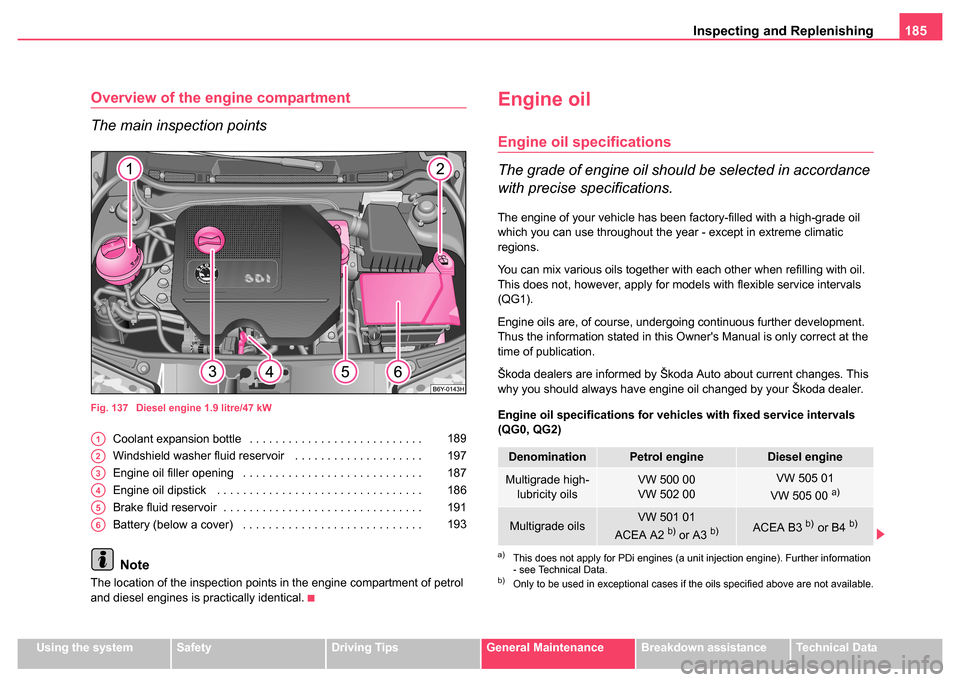
Inspecting and Replenishing185
Using the systemSafetyDriving TipsGeneral MaintenanceBreakdown assistanceTechnical Data
Overview of the engine compartment
The main inspection points
Fig. 137 Diesel engine 1.9 litre/47 kW
Coolant expansion bottle . . . . . . . . . . . . . . . . . . . . . . . . . . .
Windshield washer fluid reservoir . . . . . . . . . . . . . . . . . . . .
Engine oil filler opening . . . . . . . . . . . . . . . . . . . . . . . . . . . .
Engine oil dipstick . . . . . . . . . . . . . . . . . . . . . . . . . . . . . . . .
Brake fluid reservoir . . . . . . . . . . . . . . . . . . . . . . . . . . . . . . .
Battery (below a cover) . . . . . . . . . . . . . . . . . . . . . . . . . . . .
Note
The location of the inspection points in the engine compartment of petrol
and diesel engines is practically identical.
Engine oil
Engine oil specifications
The grade of engine oil should be selected in accordance
with precise specifications.
The engine of your vehicle has been factory-filled with a high-grade oil
which you can use throughout the year - except in extreme climatic
regions.
You can mix various oils together with each other when refilling with oil.
This does not, however, apply for models with flexible service intervals
(QG1).
Engine oils are, of course, undergoing continuous further development.
Thus the information stated in this Owner's Manual is only correct at the
time of publication.
Škoda dealers are informed by Škoda Auto about current changes. This
why you should always have engine oil changed by your Škoda dealer.
Engine oil specifications for vehicles with fixed service intervals
(QG0, QG2)
A1189
A2197
A3187
A4186
A5191
A6193
DenominationPetrol engineDiesel engine
Multigrade high-
lubricity oilsVW 500 00
VW 502 00VW 505 01
VW 505 00 a)
a)This does not apply for PDi engines (a unit injection engine). Further information
- see Technical Data.
Multigrade oilsVW 501 01
ACEA A2 b) or A3 b)
b)Only to be used in exceptional cases if the oils specified above are not available.
ACEA B3 b) or B4 b)
Page 194 of 247

Inspecting and Replenishing193
Using the systemSafetyDriving TipsGeneral MaintenanceBreakdown assistanceTechnical Data
The battery
Working on the battery
The battery is located in the engine compartment below a cover*.
– Pull off the catch on the side of the battery cover , place the
battery cover at about 45° and remove the battery cover in
direction ⇒fig. 142.
– Pull off the catch on the side of the battery cover and swing the battery cover in the direction ⇒fig. 143 .
– The installtion of the battery cover takes place in the reverse order.
Removal and installation of the battery is not recommended since it can,
under certain circumstances, lead to major damage to the battery and
fuse boxes. Please contact your Škoda dealer.
There is a risk of injuries, scalding, accidents and burns when carrying out
any work on the battery and on the electrical system. It is essential to
comply with the warning instructions stated below ⇒ and with the
general applicable rules of safety.
WARNING
•The battery acid is strongly corrosive and must, therefore, be
handled with the greatest of care. Always wear protective gloves,
eye and skin protection when handling batteries. Corrosive fumes
in the air irritate the air passages and lead to conjunctivitis and
inflammation of the air passages in the lungs. Battery acid
corrodes dental enamel and creates deep wounds after contact
with the skin which take a long time to heal. Repeated contact with
diluted acids causes skin diseases (inflammations, ulcers, slin
cracks). Acids coming into contact with water are diluted accompa-
nied by significant development of heat.
•Do not tilt the battery otherwise battery electrolyte may flow out
of the battery vent openings. Protect the eyes with safety glasses
Fig. 142 Engine
compartment: The
battery
Fig. 143 The battery:
Open up the cover
A1
AA
A2
AB
Page 195 of 247

Inspecting and Replenishing
194
or a shield! There is the danger of suffering blindness! If any
battery electrolyte gets into your eye, rinse out your eye immedi-
ately with clear water for severa l minutes. Contact a doctor without
delay.
•Splashes of acid on your skin or clothes should be neutralised
as soon as possible using soap suds and then rinsed with plenty
of water. Contact a doctor immediately if you swallow battery elec-
trolyte.
•Keep batteries out of the reach of children.
•Hydrogen is released when you charge a battery and a highly
explosive gas mixture is produced. An explosion can be caused
through sparkling over during unclamping or loosening of the
cable plug while the ignition is on.
•Bridging of the poles will create a short circuit (e.g. through
metal objects, cables). Possible consequences of a short circuit:
Melting of lead struts, explosion and burning of the battery, jets of
acid spurting out.
•It is prohibited to work with a naked flame and light, to smoke or
to carry out any activities which produce sparks. Avoid creating
sparks when working with cables and electrical devices. Strong
sparking represents a risk of injury.
•Before carrying out any work on the electrical system, switch
off the engine, the ignition as well as all electrical components and
disconnect the negative cable (-) on the battery (please pay atten-
tion to the following instructions ⇒page 196). If you wish to
replace a bulb it is sufficient to switch off the appropriate light.
•Never charge a frozen or thawed battery - risk of explosion and
caustic burns. Replace a frozen battery.
•Never use a battery which is damaged - risk of explosion! Imme-
diately replace a damaged battery.
Caution
•You must only disconnect the battery if the ignition is switched on,
otherwise the electrical system (electronic components) of the vehicle
may be damaged. When disconnecting the battery from the electrical
system of the vehicle, first disconnect the negative terminal (-) of the
battery. Then disconnect the positive terminal (+).
•When reconnecting the battery, first connect the positive terminal (+)
and only then the negative terminal (-) of the battery. You must on no
account connect the cables wrongly - risk of a cable fire.
•Ensure that battery acid does not come into contact with the vehicle
body otherwise damage could occur to the paintwork.
•Do not place the battery in direct daylight in order to protect the battery
housing from the effects of ultra-violet light.
For the sake of the environment
A removed battery is a special type of waste which is harmful to the envi-
ronment - contact your Škoda dealer regarding disposing of the battery.
Note
Please also refer to the guidelines ⇒page 196, “Disconnecting and
reconnecting the battery”, also after connecting the battery.
WARNING (continued)
Page 196 of 247
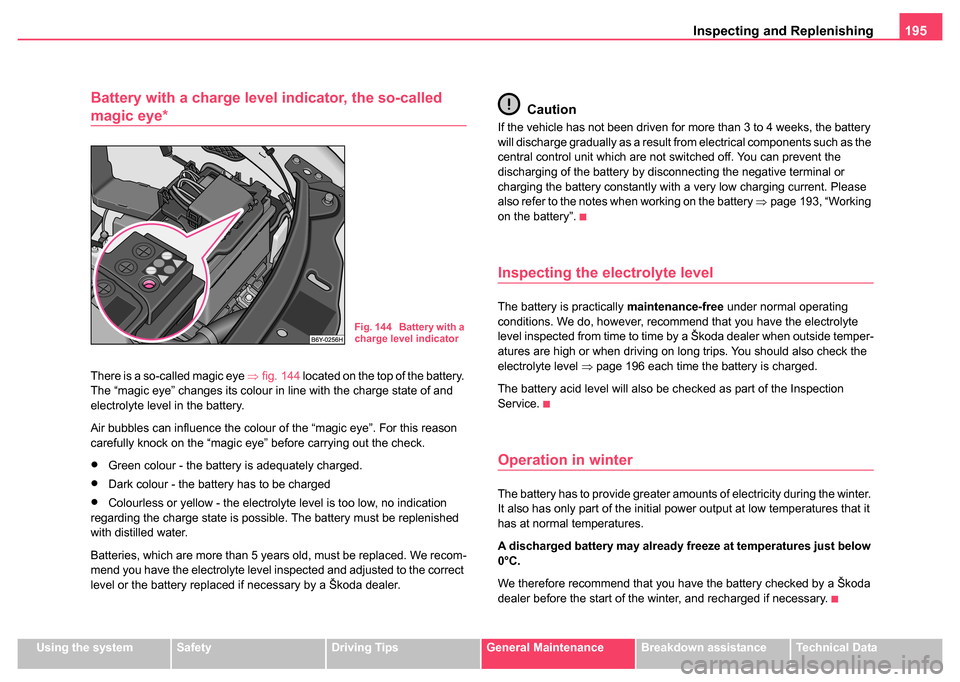
Inspecting and Replenishing195
Using the systemSafetyDriving TipsGeneral MaintenanceBreakdown assistanceTechnical Data
Battery with a charge level indicator, the so-called
magic eye*
There is a so-called magic eye ⇒fig. 144 located on the top of the battery.
The “magic eye” changes its colour in line with the charge state of and
electrolyte level in the battery.
Air bubbles can influence the colour of the “magic eye”. For this reason
carefully knock on the “magic eye” before carrying out the check.
•Green colour - the battery is adequately charged.
•Dark colour - the battery has to be charged
•Colourless or yellow - the electrolyte level is too low, no indication
regarding the charge state is possible. The battery must be replenished
with distilled water.
Batteries, which are more than 5 years old, must be replaced. We recom-
mend you have the electrolyte level inspected and adjusted to the correct
level or the battery replaced if necessary by a Škoda dealer.
Caution
If the vehicle has not been driven for more than 3 to 4 weeks, the battery
will discharge gradually as a result from electrical components such as the
central control unit which are not switched off. You can prevent the
discharging of the battery by disconnecting the negative terminal or
charging the battery constantly with a very low charging current. Please
also refer to the notes when working on the battery ⇒page 193, “Working
on the battery”.
Inspecting the electrolyte level
The battery is practically maintenance-free under normal operating
conditions. We do, however, recommend that you have the electrolyte
level inspected from time to time by a Škoda dealer when outside temper-
atures are high or when driving on long trips. You should also check the
electrolyte level ⇒page 196 each time the battery is charged.
The battery acid level will also be checked as part of the Inspection
Service.
Operation in winter
The battery has to provide greater amounts of electricity during the winter.
It also has only part of the initial power output at low temperatures that it
has at normal temperatures.
A discharged battery may already freeze at temperatures just below
0°C.
We therefore recommend that you have the battery checked by a Škoda
dealer before the start of the winter, and recharged if necessary.
Fig. 144 Battery with a
charge level indicator